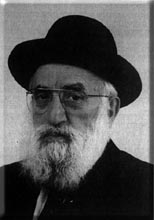Beit Midrash
- Sections
- Chemdat Yamim
- Parashat Hashavua
- Torah Portion and Tanach
- D'varim
- Va'etchanan
We find in many places that l’fanim means in the past. Devarim 2:10 uses that term to refer to the period in which the Eimim once lived in the land of the Moavites. Yehoshua (11:10) talks about how Chatzor was l’fanim the head city of the nations of the area. Shmuel (I:9:9) relates how l’fanim, what we now call a navi was once called a ro’eh. In all of these case, the word which literally could be translated as in the direction of the face (as opposed to the back) talks about "back" in history, not the times that are in front of us in the future. The simple explanation in our vernacular is that lifnei does not only mean in the direction of the face, but before.
In the opposite direction, the word l’achor, which can be translated as in the direction of the back, refers to later on. In describing the magnitude of the locust in Egypt, the pasuk says: "…l’fanav there was not such a thing and acharav there will not be" (Shemot 10:14). Here too, even though the back would seem to point back to the past, the idea is that acharav means afterward, which actually is in the future. Thus, Kohelet (3:22) can say: "… it is his portion, for who will bring him to see that which is acharav." He repeats that usage in Kohelet 6:12.
But we can give the following philosophical perspective on this interesting etymological phenomenon of two ways of looking at the past and the future. The proper way to know how to look into and prepare for the future is by looking behind us into history. Only if we can learn from the experiences of the forefathers, will we internalize their path and be able to march along the trail that they blazed for us. We can then plan our future, even though it is shrouded in fog and secrecy. The attempt to march forward and look to the future, with the assumption that the new is better than the old, is like walking with one’s eyes shut, for one will never know what will be after him.
Specifically in a generation of technological advancement, which can bring great blessing, the best way to advance is by using new scientific ideas in light of what we have seen in our past. Then that which is behind us (i.e., the future) will be safer. (See more on this in Tzofnat Yeshayahu from pg. 272 and on, including in the footnotes.)

Parashat Hashavua: “Kings Will Descend from You”
Rabbi Yossef Carmel | Kislev 5786

Parashat Hashavua: Divinely Ordained Sibling Deceit
Rabbi Yossef Carmel | Cheshvan 5786

Parashat Hashavua: How to Ensure a Future of Torah
Rabbi Yossef Carmel | Cheshvan 5786






















